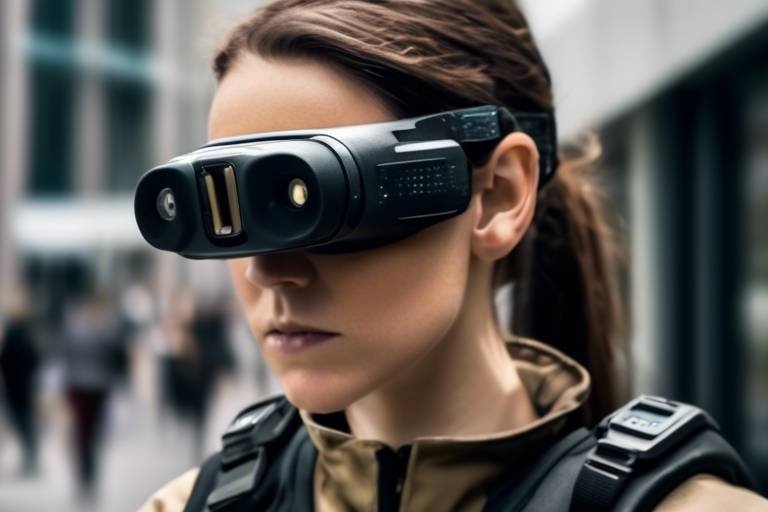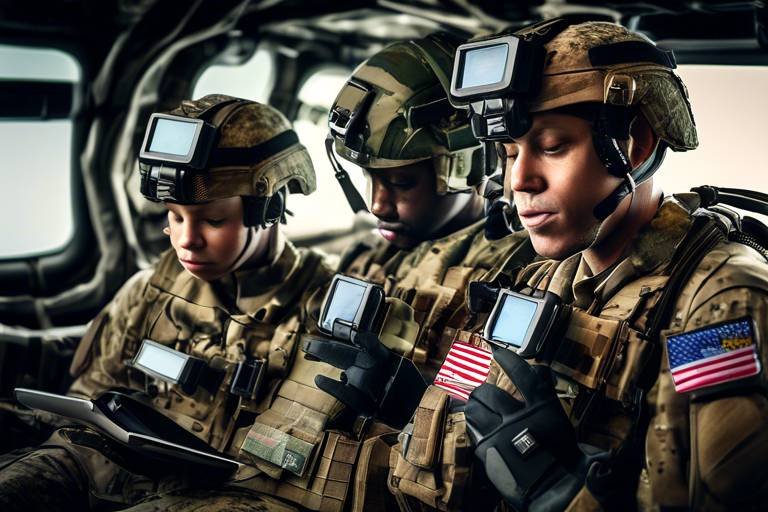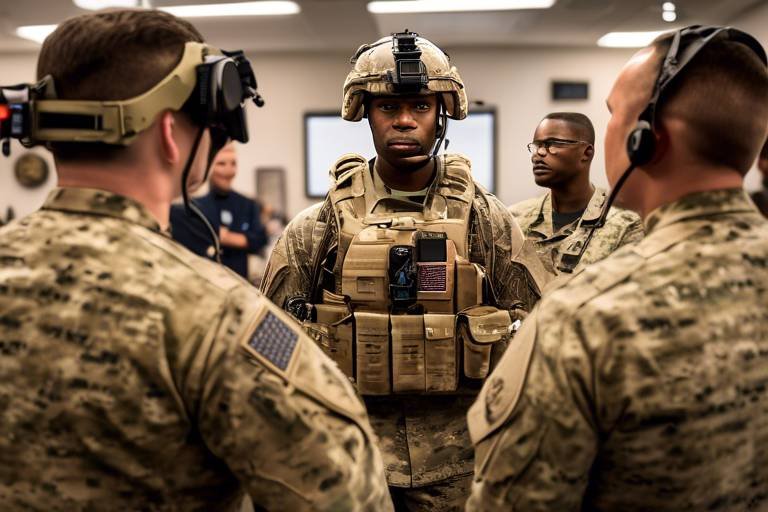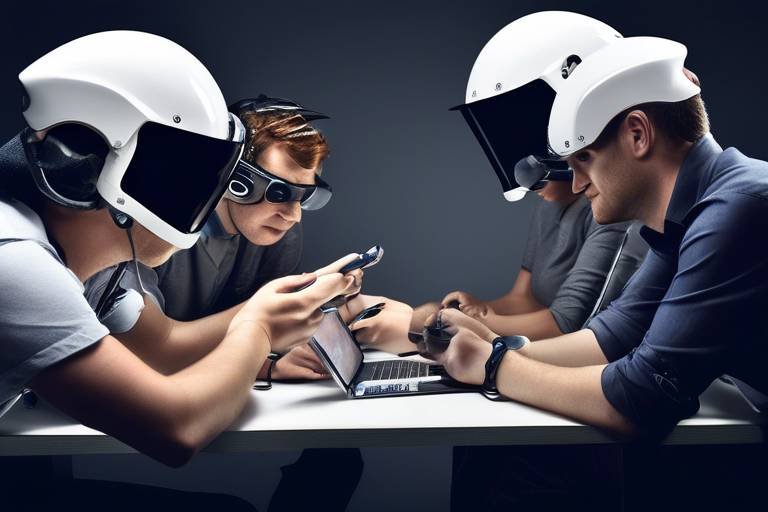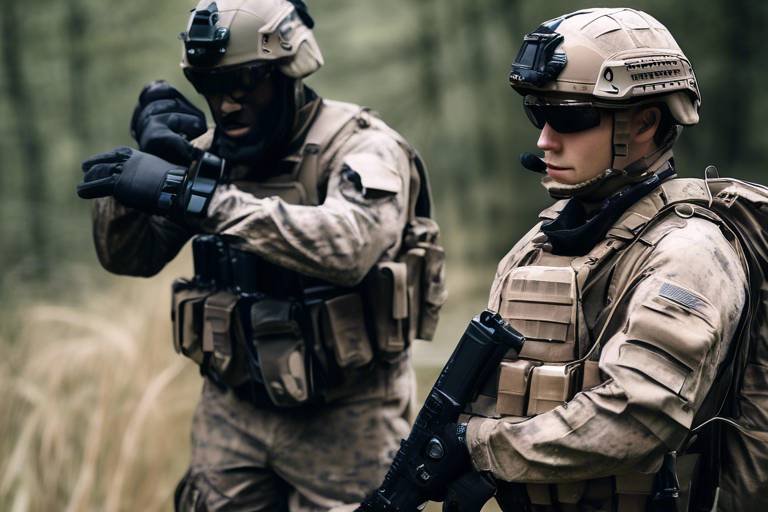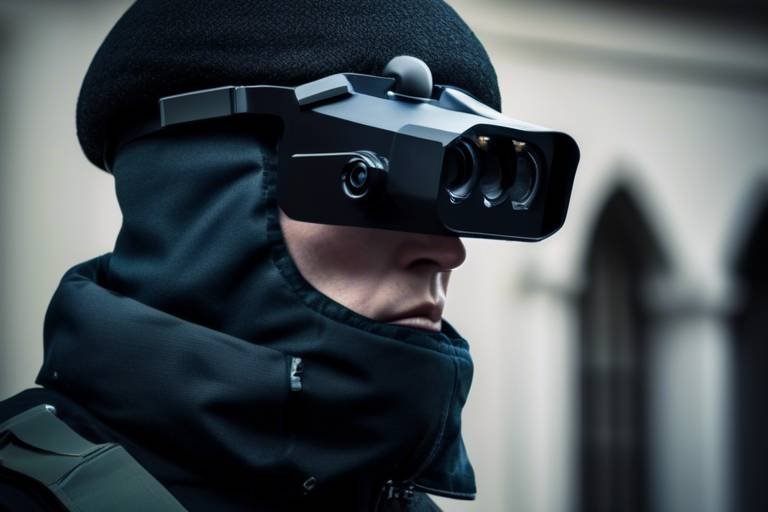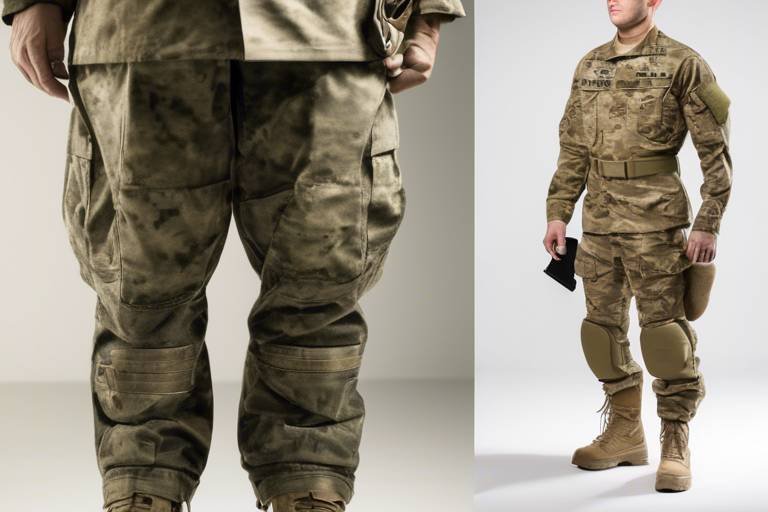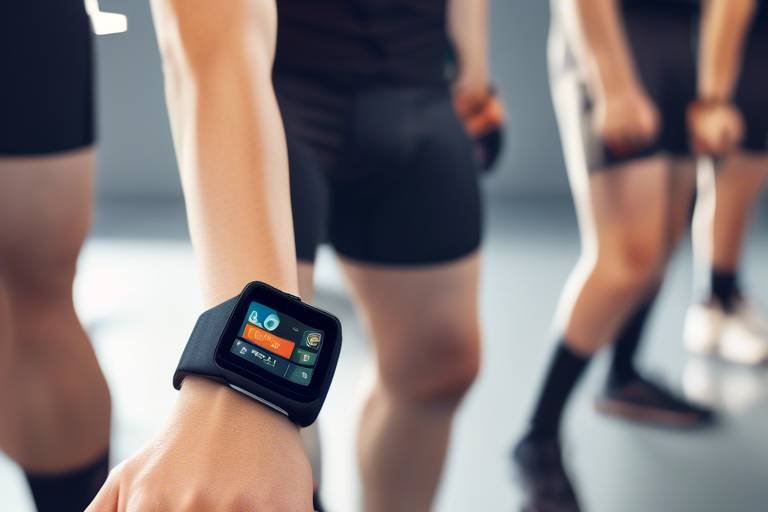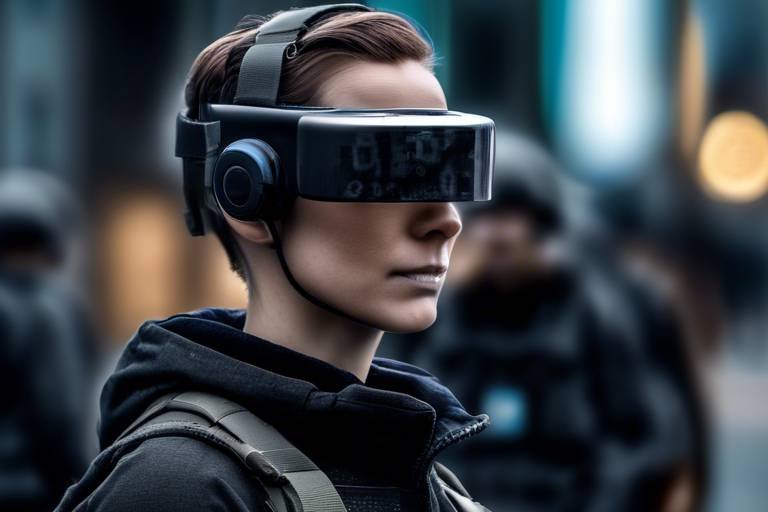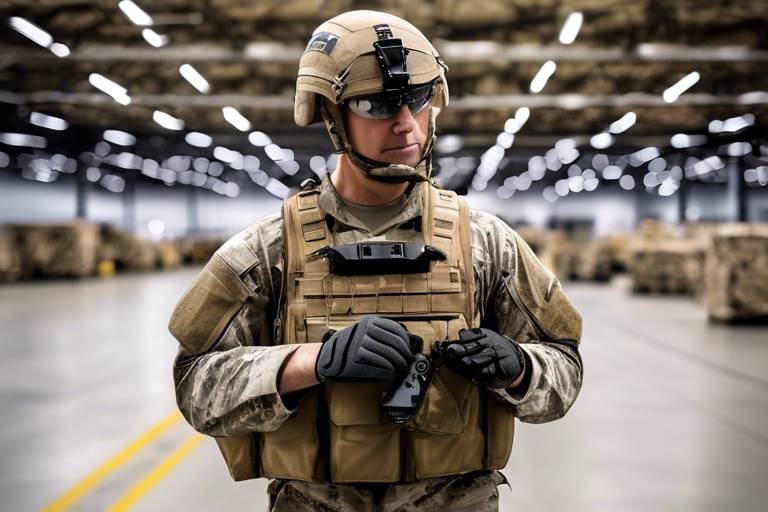How Wearable Devices Aid in Non-Lethal Engagement Scenarios
In today's world, where safety and security are paramount, the emergence of wearable devices has revolutionized the way we approach non-lethal engagements. These devices, which can be worn comfortably on the body, offer a myriad of functionalities that enhance not only personal safety but also the effectiveness of law enforcement operations. Imagine a scenario where officers can monitor their physiological state while engaging with the community, ensuring both their safety and the well-being of those they serve. This article delves into the various applications of wearable technology, highlighting its impact on law enforcement and personal safety.
Wearable technology encompasses a wide range of devices designed to be worn on the body, providing functionalities that extend beyond mere convenience. These devices can track health metrics, facilitate communication, and collect vital data. As we navigate through different environments, the significance of these gadgets becomes increasingly evident. For instance, think about a police officer on duty who can access real-time data about their heart rate or stress levels. Such information can be crucial during tense situations, allowing for informed decision-making. The integration of these devices not only enhances individual safety but also transforms engagement strategies, making them more effective and responsive.
The adoption of wearable devices in law enforcement is not just a trend; it is a necessity. These devices significantly enhance situational awareness, improve communication among officers, and ensure accountability during non-lethal engagements. By leveraging technology, law enforcement agencies aim to reduce violence and foster better relations with the communities they serve. For example, when officers wear body cameras, they not only document their interactions but also create a transparent environment where accountability is prioritized.
Body cameras have emerged as vital tools for law enforcement agencies. These devices capture real-time footage of interactions and engagements, providing a crucial layer of transparency. Imagine an officer responding to a call; with a body camera, every detail of the encounter is recorded. This footage can serve multiple purposes, from evidence collection to training resources, ensuring that all parties are held accountable during non-lethal scenarios. The presence of body cameras can also act as a deterrent for misconduct, as both officers and civilians are aware that their actions are being documented.
The implementation of body cameras has proven to significantly increase accountability among officers. With a clear record of events, these devices allow for thorough reviews and analyses of interactions. This level of scrutiny ensures that proper conduct is maintained, particularly during non-lethal engagements. When officers know they are being recorded, it encourages them to adhere to protocols and engage with the community in a respectful manner.
Furthermore, body cameras play a crucial role in shaping public perception of law enforcement. Their presence can enhance community trust, fostering a more collaborative relationship. When citizens see that officers are committed to transparency, it can lead to improved interactions and a sense of safety within the community. This shift in perception is essential for building bridges between law enforcement and the public.
Health monitoring wearables are another facet of wearable technology that can be instrumental during non-lethal engagements. These devices assess the physical condition of individuals involved, providing real-time data that can inform decision-making. For instance, if an officer's heart rate spikes during a tense situation, it may signal the need for de-escalation tactics. By ensuring the well-being of all parties involved, these devices contribute to safer outcomes.
Wearable devices are also transforming training environments for law enforcement and security personnel. By simulating non-lethal engagement scenarios, these tools allow individuals to practice and refine their skills in a controlled and safe setting. The use of technology in training not only enhances preparedness but also builds confidence in handling real-world situations.
One of the most exciting advancements in training is the use of virtual reality (VR). VR training programs utilize wearables to create immersive scenarios, allowing participants to experience realistic non-lethal engagements. This technology enhances decision-making skills and prepares officers for the complexities of real-world interactions. Imagine donning a VR headset and stepping into a simulated environment where you must navigate a challenging engagement—this level of training is invaluable.
Additionally, wearable devices can track performance metrics during training exercises. This data provides valuable feedback, helping individuals and teams improve their responses and techniques in non-lethal engagement situations. By analyzing performance data, trainers can identify areas for improvement, ensuring that law enforcement personnel are always at their best when it matters most.
While the benefits of wearable devices in non-lethal engagements are clear, they also raise important ethical questions. Issues surrounding privacy, consent, and the potential for misuse necessitate careful consideration. As we embrace technology, we must also ensure that its implementation respects individual rights and promotes safety.
The integration of wearable technology in public settings can lead to privacy concerns. Individuals may be monitored without their consent, prompting discussions about the balance between safety and personal privacy. It is crucial for law enforcement agencies to establish guidelines that protect citizens while utilizing these devices for public safety.
Establishing regulatory frameworks is essential to govern the use of wearable devices in non-lethal engagements. These frameworks should ensure that the implementation of technology respects individual rights while enhancing safety and accountability. By creating clear guidelines, we can navigate the complexities of technology in law enforcement responsibly.
- What are wearable devices?
Wearable devices are technology that can be worn on the body and are designed to perform various functions such as tracking health metrics, enhancing communication, and collecting data. - How do body cameras enhance accountability?
Body cameras provide a clear record of interactions, allowing for thorough reviews of conduct during non-lethal engagements, which increases accountability among officers. - What are the ethical concerns associated with wearable technology?
Ethical concerns include privacy issues, consent for monitoring, and the potential for misuse of data collected by wearable devices. - How does virtual reality training benefit law enforcement?
Virtual reality training allows officers to practice realistic non-lethal engagements in a controlled environment, enhancing their decision-making skills and preparedness.
Understanding Wearable Technology
Wearable technology is revolutionizing the way we interact with our environment, providing us with tools that enhance our daily lives in ways we never thought possible. These devices, which can be worn on the body, are designed to perform a variety of functions, ranging from health monitoring to communication and data collection. Imagine having a personal assistant strapped to your wrist or a device that can alert you to potential health issues before they become serious. This is the promise of wearable technology, and its impact on personal safety and engagement strategies is profound.
At its core, wearable technology encompasses a broad spectrum of devices, including smartwatches, fitness trackers, and even smart clothing. Each of these devices serves a unique purpose, yet they all share a common goal: to provide users with real-time information that can enhance decision-making and improve safety. For instance, health monitoring devices can track vital signs like heart rate and blood pressure, alerting users to any anomalies that may require medical attention. Similarly, communication devices can ensure that users remain connected, even in the most challenging environments.
Moreover, wearable devices are equipped with sensors and connectivity capabilities that allow them to gather and transmit data seamlessly. This data can be analyzed to provide insights into user behavior, health trends, and even environmental conditions. As a result, organizations, particularly in law enforcement, are beginning to leverage this technology to enhance situational awareness and improve engagement strategies. By integrating wearable technology into their operations, law enforcement agencies can not only increase their efficiency but also foster a sense of security within the communities they serve.
In summary, wearable technology is more than just a trend; it represents a significant shift in how we approach safety and engagement. Its ability to provide real-time data, enhance communication, and monitor health conditions makes it an invaluable asset in various fields, particularly in law enforcement. As we continue to explore the potential of these devices, it becomes increasingly clear that they will play a crucial role in shaping the future of personal safety and community interaction.
Applications in Law Enforcement
Wearable devices are revolutionizing the way law enforcement agencies operate, enhancing both safety and effectiveness during non-lethal engagements. These devices are not just trendy gadgets; they are becoming essential tools in the field, providing officers with the ability to gather critical information, improve communication, and foster accountability. Imagine a world where officers can access real-time data while on the move, ensuring they are always a step ahead in potentially volatile situations. This is the power of wearable technology in law enforcement.
One of the most significant applications of wearable devices is in the realm of situational awareness. Officers equipped with smart glasses or heads-up displays can receive live updates about their surroundings, including information about suspects or ongoing incidents. This capability allows them to make informed decisions quickly, potentially diffusing situations before they escalate. Additionally, wearable communication devices enable seamless coordination among team members, ensuring that everyone is on the same page during critical moments.
Moreover, the use of wearable technology promotes accountability within law enforcement. Body cameras, for instance, have become a staple in many police departments. These cameras not only record interactions between officers and the public but also serve as a deterrent against misconduct. When officers know they are being recorded, they are more likely to adhere to proper protocols, resulting in a decrease in incidents of excessive force. The data collected from these devices can be analyzed later, providing valuable insights into officer behavior and community interactions.
| Wearable Device | Function | Benefits |
|---|---|---|
| Body Cameras | Record interactions | Enhances accountability and transparency |
| Smart Glasses | Provide real-time data | Improves situational awareness |
| Health Monitors | Track officer vitals | Ensures physical well-being during engagements |
Health monitoring wearables are another critical component in the law enforcement toolkit. These devices can track the physical condition of officers during engagements, providing real-time data on heart rates, stress levels, and overall health. This information is vital, especially in high-stress situations where officers may be pushed to their limits. By monitoring their health, agencies can intervene if an officer is showing signs of distress, ensuring their safety and well-being.
In summary, the applications of wearable devices in law enforcement are vast and varied. From enhancing situational awareness and communication to promoting accountability and ensuring officer health, these technologies are transforming how law enforcement agencies engage with the communities they serve. As these devices continue to evolve, they will undoubtedly play a crucial role in shaping the future of policing.
- What types of wearable devices are commonly used in law enforcement? Body cameras, smart glasses, and health monitoring devices are among the most commonly used wearables.
- How do body cameras improve accountability? Body cameras provide a recorded account of interactions, which can be reviewed to ensure proper conduct and transparency.
- Can health monitoring devices really make a difference in officer safety? Yes, by tracking vital signs in real-time, these devices can alert agencies to potential health issues before they escalate.
Body Cameras
Body cameras have become indispensable tools in the toolkit of modern law enforcement, revolutionizing the way police interactions are documented and scrutinized. These compact devices, worn on an officer's uniform, capture high-definition video and audio of encounters, providing a transparent view of events as they unfold. Imagine walking into a situation where every word and action is recorded—this not only serves as a safeguard for the public but also protects officers from false accusations. In a world where trust is paramount, body cameras serve as a bridge, fostering accountability and transparency.
One of the most significant advantages of body cameras is their ability to provide real-time evidence. This footage can be crucial in investigations, helping to clarify the details of an incident and serving as an impartial witness. When disputes arise about what happened during an engagement, these recordings can be the deciding factor. They can also act as a deterrent for both officers and civilians, knowing that their actions are being recorded. This leads to more measured behavior and, ultimately, a reduction in confrontational situations.
Moreover, the implementation of body cameras has shown a remarkable impact on community relations. When citizens are aware that their interactions with law enforcement are being recorded, they may feel more secure and respected. This transparency can help to build trust, as communities see that law enforcement agencies are committed to accountability. In fact, studies have indicated that the presence of body cameras can lead to a decrease in complaints against officers and a reduction in the use of force incidents. This is a win-win situation, enhancing safety for all parties involved.
However, the deployment of body cameras is not without its challenges. Issues surrounding data storage, access to footage, and privacy concerns are at the forefront of discussions about their use. For instance, who has the right to access this footage? How long should it be stored? These are critical questions that need to be addressed to ensure that body cameras fulfill their intended purpose without infringing on individual rights.
In summary, body cameras are a pivotal advancement in law enforcement technology, significantly enhancing accountability and community trust. As we move forward, it's crucial to continue refining the policies surrounding their use, ensuring that they serve as a tool for safety and transparency rather than a source of contention.
- What are body cameras? Body cameras are recording devices worn by law enforcement officers to capture video and audio of their interactions with the public.
- How do body cameras improve accountability? They provide a clear record of events that can be reviewed to ensure proper conduct during engagements.
- Do body cameras help build community trust? Yes, their presence can enhance public perception and foster a more collaborative relationship between law enforcement and the community.
- What are the privacy concerns associated with body cameras? Issues arise regarding who can access the footage and how long it should be stored, leading to discussions about balancing safety and privacy.
Impact on Accountability
In recent years, the introduction of body cameras has revolutionized the way law enforcement agencies operate, particularly in non-lethal engagement scenarios. These devices not only serve as a tool for capturing real-time footage of interactions but also play a crucial role in enhancing accountability among officers. Imagine a world where every interaction between police and civilians is recorded, providing a transparent view of events as they unfold. This level of oversight ensures that both parties are aware they are being monitored, which can significantly influence behavior.
When officers wear body cameras, they are less likely to engage in misconduct, knowing that their actions are being documented. This has led to a notable decrease in complaints against law enforcement officers. According to studies, agencies that have adopted body cameras have reported a reduction of up to 90% in complaints against officers. This statistic not only highlights the effectiveness of body cameras in promoting good conduct but also fosters a sense of trust between the community and law enforcement.
Moreover, the footage captured by body cameras can serve as invaluable evidence in investigations, ensuring that any disputes regarding the conduct of officers or civilians can be resolved with clarity. In a world where perception can sometimes overshadow reality, having concrete evidence can make all the difference. For instance, if an officer is accused of using excessive force, the footage can be reviewed to determine the truth of the allegations, thus protecting both the officer and the civilian involved.
However, the impact of body cameras on accountability extends beyond just individual cases. The data collected can be analyzed to identify trends in behavior, allowing agencies to implement training programs tailored to specific needs. For example, if footage shows a consistent pattern of complaints regarding a particular officer's interactions, this can trigger a review and subsequent training to address these issues. This proactive approach not only enhances accountability but also contributes to a culture of continuous improvement within law enforcement agencies.
While the benefits of body cameras are evident, it is essential to recognize that their implementation must be accompanied by clear policies and guidelines to ensure responsible use. Agencies must establish protocols regarding when cameras should be activated, how footage is stored, and who has access to it. This is crucial in maintaining the integrity of the data and protecting the privacy rights of individuals captured in the recordings.
In summary, the impact of body cameras on accountability in non-lethal engagements cannot be overstated. They serve as a powerful tool for transparency, helping to build trust between law enforcement and the communities they serve. As technology continues to evolve, the role of wearable devices in enhancing accountability will likely expand, paving the way for a more equitable and just society.
- What are body cameras and how do they work? Body cameras are small recording devices worn by law enforcement officers that capture video and audio of interactions with the public.
- How do body cameras improve accountability? They provide a transparent record of events, which can help resolve disputes and reduce instances of misconduct.
- Are there privacy concerns associated with body cameras? Yes, there are concerns about monitoring individuals without consent, which necessitates clear policies on usage and data handling.
- What happens to the footage recorded by body cameras? Footage is typically stored securely and can be reviewed for investigations or training purposes, following established protocols.
Public Trust and Perception
In today's world, the relationship between law enforcement and the communities they serve is more critical than ever. Body cameras have emerged as a beacon of transparency, illuminating the often murky waters of police interactions. When officers wear these devices, it sends a clear message: "We are accountable for our actions." This simple yet profound shift can significantly enhance public trust. Imagine a community where citizens feel secure knowing that their interactions with law enforcement are being recorded. It’s like having a safety net that ensures everyone plays by the rules.
Moreover, the presence of body cameras can alter the behavior of both officers and civilians. When people know they are being recorded, they tend to act more responsibly. This phenomenon can lead to a decrease in confrontational situations, as individuals are more likely to think twice before escalating a conflict. In essence, body cameras act as a mirror, reflecting the actions of all parties involved and encouraging a more respectful dialogue.
However, the impact of body cameras on public perception goes beyond mere accountability. They serve as a tool for building bridges between law enforcement and the community. When footage from body cameras is made available to the public, it can demystify police procedures and decisions. This transparency fosters a sense of collaboration and understanding, as community members gain insight into the challenges officers face. It’s akin to pulling back the curtain on a stage performance—what was once hidden is now visible, allowing for a more informed and engaged audience.
To further illustrate the positive effects of body cameras on public trust, consider the following statistics:
| Statistic | Impact |
|---|---|
| 93% of officers reported feeling more accountable | Increased professionalism during engagements |
| 75% of citizens felt safer when body cameras were present | Enhanced community relations and cooperation |
| 50% reduction in complaints against officers | Improved officer-civilian interactions |
While the benefits of body cameras are significant, it is essential to address concerns regarding privacy and the potential misuse of footage. The balance between ensuring safety and respecting individual rights is delicate. Communities must engage in open dialogues with law enforcement about how footage is used, who has access to it, and how long it is retained. This ongoing conversation is crucial for maintaining the trust that body cameras can help build.
In conclusion, body cameras are not merely technological gadgets; they are powerful instruments for change. By fostering transparency and accountability, they can reshape the narrative between law enforcement and the communities they serve. As we move forward, it is vital to embrace this technology while also ensuring that ethical considerations are at the forefront of its implementation.
- What are body cameras? Body cameras are recording devices worn by police officers to capture video and audio of their interactions with the public.
- How do body cameras enhance public trust? They provide transparency, ensuring accountability for officers' actions and fostering a sense of security within the community.
- What are the privacy concerns associated with body cameras? Privacy concerns arise when individuals are recorded without their consent, leading to discussions about the balance between safety and personal privacy.
- How is the footage from body cameras used? The footage can be used for evidence in investigations, training purposes, and to review officer conduct during engagements.
- Are there regulations governing the use of body cameras? Yes, many jurisdictions have established guidelines to ensure responsible use, retention, and access to body camera footage.
Health Monitoring Devices
In today's fast-paced world, have emerged as crucial tools, especially in high-stakes environments like law enforcement. These devices, which can be worn on the body, are designed to track various health metrics such as heart rate, blood pressure, and even stress levels. Imagine a scenario where an officer is engaged in a tense situation; having access to real-time health data can be the difference between maintaining composure and succumbing to stress. These devices not only keep track of the wearer's physical condition but also provide critical insights that can inform decision-making processes during non-lethal engagements.
For instance, if an officer's heart rate spikes significantly, it could indicate heightened stress or potential health risks. This data can be invaluable, prompting immediate action to ensure the officer's well-being. Health monitoring wearables can also assist in assessing the physical condition of civilians involved in an engagement, ensuring that all parties are safe and capable of participating in the interaction. This is particularly important in situations where the emotional and physical state of individuals can influence the outcome of the engagement.
Moreover, the integration of health monitoring devices into law enforcement practices can enhance overall situational awareness. Officers equipped with these devices can receive alerts about their own health status or that of their colleagues, enabling them to make informed decisions quickly. The implications of this technology extend beyond mere health tracking; they foster a culture of safety and accountability within law enforcement agencies.
To illustrate the impact of health monitoring devices, consider the following table that outlines some common features and their benefits:
| Device Feature | Benefit |
|---|---|
| Real-time Heart Rate Monitoring | Identifies stress levels and potential health risks during engagements. |
| GPS Tracking | Enhances situational awareness by providing location data during operations. |
| Fall Detection | Automatically alerts emergency services if an officer falls or is incapacitated. |
| Data Logging | Tracks health metrics over time for better long-term health management. |
In conclusion, health monitoring devices are not just gadgets; they are essential tools that can significantly impact the safety and effectiveness of law enforcement during non-lethal engagements. By providing real-time data, these devices empower officers to make informed decisions, ensuring the well-being of both themselves and the communities they serve. As technology continues to evolve, the integration of health monitoring wearables in law enforcement will likely become more prevalent, paving the way for a safer and more accountable approach to public safety.
- What types of health monitoring devices are commonly used in law enforcement? Devices such as heart rate monitors, GPS trackers, and fall detection systems are commonly utilized.
- How do these devices enhance officer safety? They provide real-time health data that can alert officers to potential health risks, allowing for timely intervention.
- Are there privacy concerns associated with health monitoring devices? Yes, the use of these devices raises important questions about privacy and consent, which must be carefully considered.
- Can health monitoring devices be used during training? Absolutely! They can track performance metrics and help in assessing physical readiness during training exercises.
Training and Simulation Tools
In the rapidly evolving landscape of law enforcement and security, have become indispensable. These tools, particularly in the form of wearable devices, allow officers and personnel to engage in realistic training scenarios that mimic real-world non-lethal engagements. Imagine stepping into a virtual world where every decision you make has consequences, all while being equipped with the latest technology that tracks your performance and physiological responses. This is not just a futuristic dream; it’s happening now!
Wearable devices in training environments serve multiple purposes. They enhance realism and immersion, enabling participants to experience the pressure and adrenaline of a live situation without the associated risks. For example, individuals can don a virtual reality headset that transports them into a high-stakes scenario, where they must make split-second decisions. This kind of training is crucial because it allows officers to practice their responses to various situations, refining their skills in a controlled environment.
Moreover, the feedback provided by these wearable devices is invaluable. During training exercises, devices can monitor a range of performance metrics including heart rate, reaction time, and even stress levels. This data is collected and analyzed, offering insights that can help individuals and teams improve their techniques. For instance, if an officer's heart rate spikes during a simulated engagement, trainers can address this reaction, discussing stress management techniques and decision-making under pressure. This process not only enhances individual performance but also fosters a culture of continuous improvement within teams.
To give you a clearer picture, consider the following table that outlines some of the key features of training and simulation tools:
| Feature | Description | Benefits |
|---|---|---|
| Realistic Scenarios | Immersive training environments that replicate real-life situations. | Improves decision-making skills and situational awareness. |
| Performance Tracking | Wearable devices that monitor physiological metrics. | Provides feedback for skill enhancement and stress management. |
| Virtual Reality Integration | Use of VR technology to create engaging training experiences. | Enhances engagement and retention of training material. |
As we delve deeper into the benefits of these training tools, it’s essential to highlight the role of virtual reality (VR) training programs. VR technology allows participants to engage in scenarios that are not only realistic but also safe. By immersing themselves in a virtual environment, officers can practice de-escalation techniques, conflict resolution, and other vital skills without the risks associated with real-life encounters. This type of training is particularly beneficial in preparing for non-lethal engagements where the stakes are high, and the need for effective communication and quick thinking is paramount.
In addition to VR, the incorporation of performance tracking technology ensures that each training session is not just a routine exercise but a comprehensive learning experience. The data collected from these sessions can be used to tailor future training programs, ensuring that they address the specific needs and challenges faced by the personnel. This personalized approach to training not only boosts confidence but also equips officers with the tools they need to handle real-life situations effectively.
In conclusion, the integration of training and simulation tools, particularly those that utilize wearable technology, represents a significant leap forward in law enforcement training. By providing realistic scenarios and valuable feedback, these tools are essential in preparing officers for non-lethal engagements, ultimately leading to safer communities and better-trained personnel.
- What are wearable devices used for in training? Wearable devices are used to track performance metrics, monitor physiological responses, and create immersive training scenarios that enhance realism.
- How does virtual reality training benefit law enforcement? It allows officers to practice decision-making in high-pressure situations without real-world risks, improving their preparedness for actual encounters.
- What kind of data do wearable devices collect during training? They can collect data on heart rate, stress levels, reaction times, and overall performance metrics.
Virtual Reality Training
Virtual reality (VR) training has revolutionized the way law enforcement and security personnel prepare for non-lethal engagements. Imagine stepping into a fully immersive environment where every sound, sight, and sensation mimics a real-world scenario. With VR, officers can engage in simulated situations that would be too risky or impractical to recreate in real life. This technology allows them to practice their skills in a safe and controlled setting, which can significantly enhance their readiness for actual encounters.
One of the key advantages of VR training is its ability to create a variety of scenarios that participants might face on the job. From handling a crowd control situation to de-escalating a tense encounter, VR enables officers to experience these situations without the fear of real-world consequences. This not only helps in honing their decision-making skills but also boosts their confidence when faced with similar situations in reality.
Furthermore, VR training can be tailored to focus on specific skills that officers need to develop. For example, scenarios can be designed to emphasize communication techniques, conflict resolution, and the appropriate use of force. The immersive nature of VR allows participants to practice these skills repeatedly, leading to better retention and application during actual non-lethal engagements. The technology can even incorporate feedback mechanisms that allow trainees to review their performance, making the learning process more effective.
In addition to individual training, VR can also facilitate team exercises. Officers can work together in a shared virtual space, allowing them to practice coordination and communication as they navigate complex scenarios. This collaborative approach not only strengthens team dynamics but also fosters a sense of camaraderie that is essential in high-stress situations.
To illustrate the impact of VR training, consider the following table that compares traditional training methods with VR training:
| Aspect | Traditional Training | Virtual Reality Training |
|---|---|---|
| Realism | Limited scenarios | Highly immersive environments |
| Risk | Potential for injury | No physical risk |
| Feedback | Delayed feedback | Immediate performance analysis |
| Cost | Higher costs for physical resources | Lower long-term costs due to scalability |
As technology continues to evolve, the possibilities for VR training in law enforcement are virtually limitless. The ability to adapt and customize training scenarios ensures that officers are not only prepared but also equipped to handle the complexities of non-lethal engagements. With VR, the future of training looks promising, paving the way for safer communities and more effective law enforcement practices.
- What is virtual reality training?
Virtual reality training uses immersive technology to create realistic scenarios for law enforcement and security personnel, allowing them to practice skills in a safe environment. - How does VR training improve decision-making?
By simulating real-world situations, VR training helps officers experience the pressure and dynamics of engagements, enhancing their ability to make quick and effective decisions. - Is VR training safe?
Yes, VR training eliminates physical risks associated with traditional training methods, allowing participants to learn without the fear of injury. - Can VR training be customized?
Absolutely! VR scenarios can be tailored to focus on specific skills or situations relevant to the trainees' needs.
Performance Tracking
When it comes to enhancing the skills of law enforcement and security personnel, through wearable devices is nothing short of revolutionary. Imagine putting on a device that not only tracks your movements but also analyzes your performance in real-time. These devices can collect a wealth of data, from physical exertion levels to reaction times, providing invaluable insights that can shape training programs and improve outcomes during actual non-lethal engagements.
For instance, during a training exercise, a wearable device can monitor various metrics such as heart rate, stress levels, and even the speed at which an officer reacts to a simulated threat. This data can then be compiled into a comprehensive report, highlighting areas of strength and pinpointing aspects that require improvement. The feedback loop created by this technology allows for a tailored training experience, where each officer can work on their unique challenges, much like a coach guiding an athlete to refine their technique.
Moreover, the implementation of performance tracking doesn't just stop at individual assessments. Aggregated data from multiple officers can be analyzed to identify broader trends within a team or department. This can help in understanding how certain tactics are being executed and whether specific strategies are effective in real-world scenarios. By assessing overall performance metrics, law enforcement agencies can make informed decisions about training curricula and operational protocols.
To illustrate the impact of performance tracking, consider the following table that summarizes key metrics monitored during training sessions:
| Metric | Description | Importance |
|---|---|---|
| Heart Rate | Measures the physical exertion level of the officer during training. | Helps assess fitness levels and stress management. |
| Reaction Time | Tracks the speed at which an officer responds to stimuli. | Critical for ensuring timely and effective responses in real situations. |
| Movement Patterns | Analyzes the officer's movements during training scenarios. | Identifies areas for improvement in agility and tactical positioning. |
| Decision-Making Metrics | Evaluates the choices made during simulated engagements. | Enhances understanding of cognitive processes under pressure. |
In summary, performance tracking through wearable devices is transforming how law enforcement agencies approach training. It’s like having a personal trainer who not only motivates but also provides data-driven insights to enhance performance. As these technologies evolve, they will undoubtedly play a pivotal role in preparing officers for the complexities of real-world engagements, ensuring that they are not only effective but also safe in their operations.
- What types of wearable devices are used for performance tracking? Various devices, including smartwatches, fitness trackers, and specialized law enforcement wearables, are utilized for tracking performance metrics.
- How is the data from these devices used? The data collected can be analyzed to improve training programs, enhance individual performance, and inform operational strategies.
- Are there any privacy concerns associated with performance tracking? Yes, the use of wearable technology raises important questions about privacy and consent, necessitating clear guidelines and regulations.
- Can performance tracking help reduce incidents during engagements? Absolutely! By improving training and preparedness, performance tracking can lead to more effective and safer outcomes during non-lethal engagements.
Ethical Considerations
The integration of wearable devices in non-lethal engagements brings forth a myriad of that cannot be overlooked. As these technologies become more prevalent, it is crucial to address the implications they have on privacy, consent, and the potential for misuse. Imagine wearing a device that constantly tracks your movements or captures your interactions; this can feel like an invasion of personal space, raising questions about where the line should be drawn between safety and privacy.
One of the primary concerns is the issue of privacy. In public settings, individuals may be monitored without their explicit consent, leading to a sense of being constantly watched. This surveillance can create a chilling effect, where people alter their behavior out of fear of being recorded or judged. The balance between ensuring public safety and respecting individual privacy rights is a delicate one. It prompts a broader discussion on how much surveillance is acceptable in the name of security.
Furthermore, the potential for misuse of these devices cannot be ignored. With the ability to record and monitor comes the responsibility to use such technologies ethically. If misused, wearable devices could lead to significant breaches of trust between law enforcement and the communities they serve. This is particularly concerning in non-lethal engagements where the goal is to foster positive interactions rather than create an atmosphere of distrust.
To mitigate these concerns, establishing robust regulatory frameworks is essential. These frameworks should govern the use of wearable devices in non-lethal engagements, ensuring that their implementation respects individual rights while enhancing safety and accountability. Regulations could include:
- Clear guidelines on data collection and storage
- Mandatory consent protocols for individuals being monitored
- Regular audits to ensure compliance with ethical standards
By implementing such measures, we can work towards a system where technology serves to protect and empower individuals rather than infringe upon their rights. The conversation surrounding ethical considerations in wearable technology is ongoing, and it is vital for stakeholders—including law enforcement, policymakers, and community members—to engage in dialogue to shape a future that balances safety with respect for personal freedoms.
- What are the main ethical concerns related to wearable devices in law enforcement?
The primary concerns include privacy issues, potential misuse of data, and the need for consent from individuals being monitored. - How can regulatory frameworks help in addressing these ethical concerns?
Regulatory frameworks can provide guidelines for data collection, ensure consent protocols are followed, and establish accountability measures for law enforcement agencies. - Are there any benefits to using wearable devices in non-lethal engagements?
Yes, they can enhance situational awareness, improve communication, and foster accountability, which can lead to better outcomes in community relations. - What steps can individuals take to protect their privacy?
Individuals can advocate for transparent policies regarding the use of wearable technology and engage in discussions about their rights in public spaces.
Privacy Concerns
As we dive deeper into the world of wearable technology, it's impossible to ignore the that come along with these innovative devices. While the benefits of wearables in enhancing safety and accountability are clear, the potential for invasion of privacy raises significant questions. Imagine walking down the street, and every move you make is being monitored by a device worn by a police officer or security personnel. It sounds like something out of a sci-fi movie, right? Yet, this scenario is becoming increasingly plausible as wearable technology becomes more integrated into law enforcement practices.
One of the primary issues at hand is the lack of consent. In many situations, individuals may find themselves under surveillance without their knowledge or agreement. This can lead to feelings of distrust and anxiety among community members, as they may feel like they are constantly being watched. Moreover, the data collected from these devices could be misused, either intentionally or accidentally, leading to further violations of personal privacy. For instance, if health monitoring devices are used in a non-lethal engagement, sensitive health information could be exposed, raising ethical dilemmas about who has access to this data and how it is utilized.
Furthermore, the question of data security looms large. With the increasing amount of data generated by wearable devices, there is a heightened risk of breaches and unauthorized access. If sensitive information falls into the wrong hands, the consequences could be dire. This concern is not just limited to law enforcement; it extends to any organization that utilizes wearables for monitoring purposes. Thus, it’s crucial to establish robust security measures to protect individuals' data and maintain their trust.
To address these concerns, a balanced approach is necessary. Here are some key considerations:
- Transparency: Agencies must be open about how data is collected, used, and stored. Clear communication can help alleviate fears and build trust within communities.
- Regulatory Oversight: Implementing strict regulations regarding the use of wearable devices can help protect individual rights and ensure responsible usage.
- Consent Protocols: Establishing clear guidelines for obtaining consent from individuals before monitoring can help respect personal privacy while still enhancing safety.
Ultimately, while wearable devices hold great promise for improving safety and accountability in non-lethal engagements, it is essential to navigate the landscape with caution. Striking a balance between leveraging technology for public safety and respecting individual privacy rights is not just advisable; it’s imperative. As we move forward, ongoing dialogue among stakeholders, including law enforcement, policymakers, and community members, will be vital in shaping the future of wearable technology in a way that honors both safety and privacy.
Q1: What are the main privacy concerns associated with wearable technology in law enforcement?
A1: The main privacy concerns include lack of consent from individuals being monitored, potential misuse of collected data, and risks related to data security breaches.
Q2: How can law enforcement agencies ensure the responsible use of wearable devices?
A2: Agencies can ensure responsible use by being transparent about data collection practices, implementing regulatory oversight, and establishing consent protocols.
Q3: What role does community trust play in the use of wearable technology?
A3: Community trust is crucial as it fosters cooperation and collaboration between law enforcement and the public, which can lead to more effective and peaceful interactions during non-lethal engagements.
Regulatory Frameworks
As the use of wearable devices in non-lethal engagements becomes more prevalent, the establishment of is crucial. These frameworks serve as a guiding light, ensuring that the deployment of wearable technology respects individual rights while enhancing safety and accountability. Without proper regulations, the potential for misuse and infringement on personal privacy looms large, creating a complex landscape that both law enforcement and the public must navigate.
One of the primary goals of these regulatory frameworks is to strike a balance between the benefits of enhanced safety and the need for personal privacy. For instance, while body cameras can provide invaluable insight into law enforcement interactions, they also raise questions about what happens to the recorded footage. Who has access to it? How long is it stored? These are just a few of the questions that regulatory bodies must address.
Moreover, regulatory frameworks can help to establish clear guidelines on consent. In many situations, individuals may not be aware that they are being monitored or recorded. Therefore, regulations should mandate that law enforcement personnel inform individuals when they are being recorded, fostering a sense of transparency and trust. This is particularly important in community policing efforts, where building rapport with the public is essential.
To illustrate the components that might be included in a regulatory framework for wearable devices, consider the following table:
| Component | Description |
|---|---|
| Data Access | Regulations should specify who can access the data collected by wearable devices and under what circumstances. |
| Storage Duration | Guidelines on how long data can be stored before it must be deleted or anonymized. |
| Consent Requirements | Clear rules on obtaining consent from individuals before recording or monitoring them. |
| Use Limitations | Specifications on how data collected can and cannot be used, preventing misuse. |
In addition to these components, the regulatory frameworks should also include mechanisms for accountability. This means establishing procedures for reviewing incidents involving wearable devices to ensure that they are used appropriately. If misuse occurs, there should be clear consequences to deter future violations, thus reinforcing public trust in law enforcement.
Ultimately, the development of robust regulatory frameworks is not just about compliance; it's about fostering a culture of responsibility and transparency. As technology continues to evolve, so too must our approaches to governance. By proactively addressing these issues, we can harness the power of wearable devices to enhance safety without compromising individual rights.
- What are the main goals of regulatory frameworks for wearable devices?
The main goals include ensuring safety, protecting individual privacy, and establishing clear guidelines for data usage and consent. - How can regulatory frameworks enhance public trust?
By providing transparency and accountability in the use of wearable devices, regulatory frameworks can help build a more trusting relationship between law enforcement and the community. - What are some potential consequences of not having regulations?
Without regulations, there is a risk of misuse of data, invasion of privacy, and erosion of public trust, which can lead to significant societal issues.
Frequently Asked Questions
- What are wearable devices?
Wearable devices are technology gadgets that can be worn on the body, such as smartwatches, fitness trackers, and body cameras. They serve various purposes, including health monitoring, communication, and data collection, playing a crucial role in enhancing personal safety and engagement strategies.
- How do wearable devices assist law enforcement?
Wearable devices help law enforcement by improving situational awareness, enhancing communication, and ensuring accountability during non-lethal engagements. For instance, body cameras can capture real-time footage of interactions, which serves as vital evidence and promotes transparency.
- What is the role of body cameras in non-lethal engagements?
Body cameras are essential tools for law enforcement, as they provide a clear record of events during interactions. This footage can be analyzed to ensure proper conduct and increase accountability among officers, ultimately fostering trust between the police and the community.
- Can health monitoring devices improve safety during engagements?
Absolutely! Health monitoring wearables can assess the physical condition of individuals involved in engagements, offering real-time data that informs decision-making. This ensures the well-being of all parties and can help prevent adverse situations.
- What ethical concerns arise from using wearable technology?
The integration of wearable technology raises significant ethical questions, particularly regarding privacy and consent. There are concerns about individuals being monitored without their knowledge, which sparks discussions on balancing safety with personal privacy rights.
- How can regulatory frameworks help with the use of wearable devices?
Establishing regulatory frameworks is crucial for governing the use of wearable devices in non-lethal engagements. Such frameworks ensure that the implementation of these technologies respects individual rights while enhancing safety and accountability in public interactions.
- What are the benefits of virtual reality training with wearables?
Virtual reality training programs utilize wearables to create immersive scenarios that allow participants to experience realistic non-lethal engagements. This enhances decision-making skills and preparedness for real-world situations, making training more effective and engaging.
- How do wearable devices track performance in training?
Wearable devices can monitor various performance metrics during training exercises, such as heart rate, response time, and accuracy. This valuable feedback helps individuals and teams refine their techniques and improve their responses in non-lethal engagement situations.

